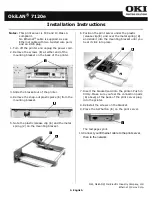
Configuring the Terminal Server 45
Setting Up Lines
Setting Up Lines
Line and port is often used interchangeably. They are almost the same, that is, each line has an
associated port number (Line 1 is port 10001 by default).
How you set up a line is really determined by the device that is connected to the line. This
section goes over some of the common ways a line is used and things that you will want to keep
in mind when configuring the line.
DSLogin
When you configure the
Line
for
DSLogin
, users connecting to the Terminal Server will have to
go through some form of authentication, either local or remote authentication. Regardless of
whether a user has been configured in the User table (local authentication) or is inheriting the
Default User’s attributes (remote or Guest authentication), when a
User
Service
is selected
(other than
DSprompt
), that connection (
Telnet
) will inherit the connection settings defined for
DSLogin
.
Direct/Silent/Reverse Connections
Direct
connections bypass the Terminal Server, enabling the user to log straight into a specific
host. A direct connection is recommended where a user logging in to the Terminal Server is not
required. It is also recommended where multiple sessions are not a requirement. Direct
connections require user interaction: the message
Press return to continue
is displayed on
the user’s screen and the session to the host is not initiated until
Enter
is pressed, after which the
host login prompt is displayed. The message is redisplayed on logout.
Silent
connections are the same as direct connections except that they are permanently
established. The host login prompt is displayed on the screen. Logging out redisplays this
prompt. Silent connections, unlike direct connections, however, make permanent use of pseudo
tty resources and therefore consume host resources even when not in use.
Reverse
connections enable a host on the network to establish a connection through the
Terminal Server port to a serial device.
Virtual Modems
Vmodem
is a feature of the Terminal Server that provides “modem like” communication between
two Terminal Servers on a network or between a Terminal Server and a host. This feature
behaves like two modems connected across a telephone line. Typically, you use the
Vmodem
feature when you have multiple devices communicating with a central site. With just a single
BLACK BOX
®
Terminal Server at each end of the network, you don’t need to use multiple
modems, avoiding the associated costs of calls and connections.
The data is sent in raw format from the virtual modem and can be received by another
Terminal
Server
or a host. This data can be sent automatically using the
Monitor DSR
option and then
configuring the host and port number of the receiver; if the receiving side is also a
Terminal
Server
, set the
Line Service
to
Rev Raw
or
Vmodem
(
Rev Raw
if the
Terminal Server
is only
receiving,
Vmodem
to initiate bidirectional data flow) and the
Terminal Server
port that the data is
coming in on (this should match the port number on the sending
Terminal Server
). Or, you can
manually start a connection by typing
ATD<ip_address>,<port_number>
and end the connection
by typing
+++ATH
. The
ip_address
can be in IPv4 or IPv6 formats and is the IP address of the
receiver. For example,
ATD123.34.23.43,10001
or you can use
ATD12334234310001
, without
any punctuation.
BIDIR
When you configure
BIDIR
, you are creating a bidirectional raw connection, meaning that the
connection can be initiated from either the ethernet or serial side.
Содержание Terminal Server
Страница 20: ...Typical Applications Summary 20 Terminal Server User Guide ...
Страница 82: ...Tools 82 Terminal Server User Guide ...
Страница 118: ...Statistic Commands 118 Terminal Server User Guide ...
Страница 124: ...COMredirect 124 Terminal Server User Guide ...
Страница 126: ...126 Terminal Server User Guide ...
Страница 130: ...W 130 Terminal Server User Guide ...
















































